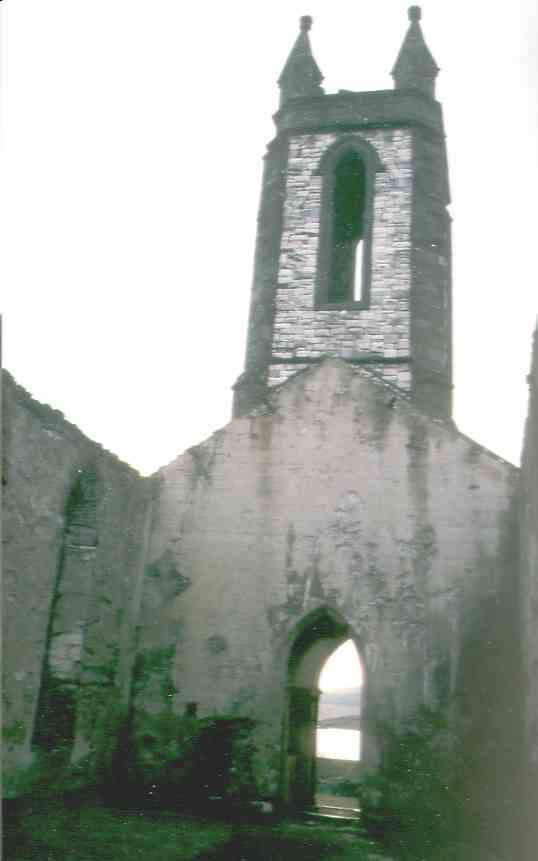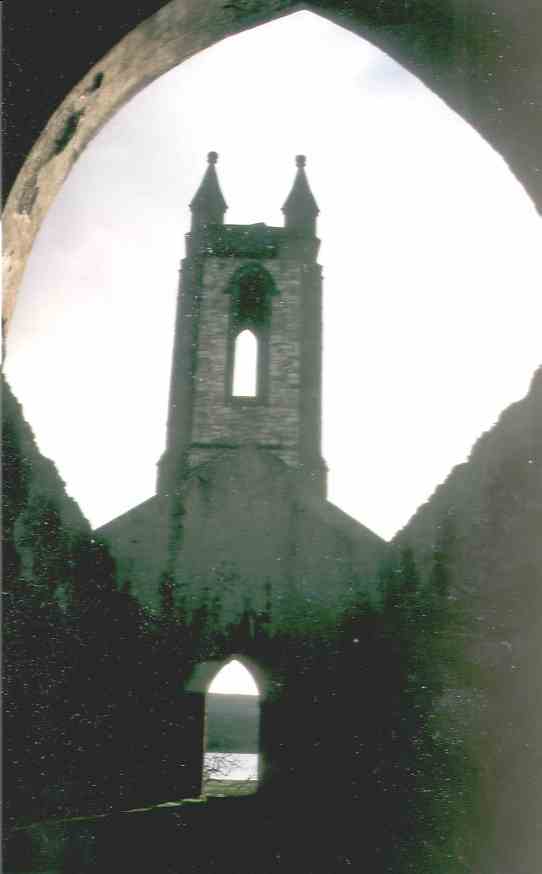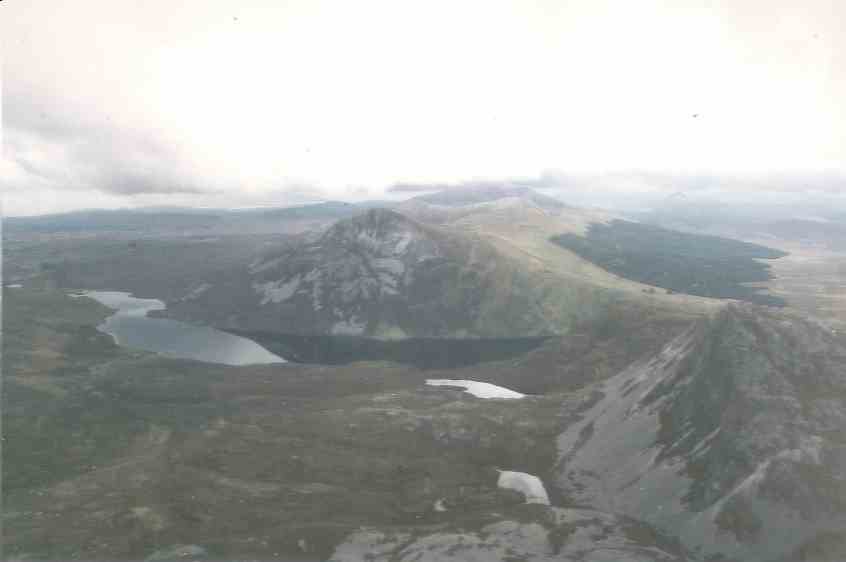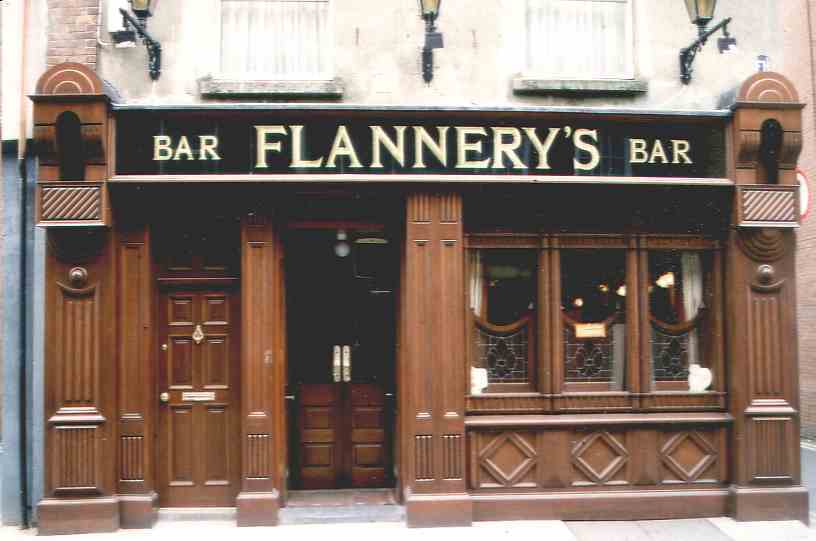To the page for Ireland of the
Trento Bike Pages
Cycling the Northwest Coast of Ireland
By and Copyright © of Klaus Offermann
The author is a free lance journalist (text and photos) and can be
reached under the following address: Klaus Offermann, Tegernseer Str.
18, D-83607 Holzkirchen, Tel. 0049/8024/1075, Fax 0049/8024/489839,
E-Mail: Klaus@Alpsys.de.
Klaus Offermann has also a bicycle travel agency and is specialized
on guided tours in Upper Bavaria, Tyrolia (Austria), Poland and New Zealand
Cycling in Ireland is a lot of fun, providing you know how to do it
right. Preparing the trip well in advance is essential. Ireland -
known as the Emerald Isle - has lots of surprises regarding the
weather. Sunshine, rain, clouds, drizzle, cold wind - it all happens
and changes within a matter of minutes. Being on the bicycle for many
hours a day, raingear as well as T-shirts have to be on top of the
cyclist luggage to be reached within seconds. Sometimes it is wise to
wait for a few minutes under a tree until the shower is over instead
of changing clothes.
The wide variety of nature offers all different cycling
conditions. You will find endless flat plains as well as hills,
mountains and even alpine passes. In order to find the right area you
would like to travel through, you should use a good map to prepare the
whole trip as well as your daily excursions. Very helpful are the
Ordnance Survey Maps with a scale of 1: 126,720 which is _ inch to 1
mile. However, these maps, which are available at bookstores or gas
stations in Ireland, are being superseded by a new system in a scale
of 1: 50.000. Whenever you can get the old maps, purchase them.
Be careful in scheduling the length of your daily trip. Hills and wind
from the front (usually westwind) can give you a hard time and your
expected average will drop down rapidly. These facts are important to
know in case you have to reach a specific place at night which is why
you should avoid too strict a schedule.
We cycled Ireland with our complete camping equipment: tent, air
mattress, sleeping bag and gas cooker. Campsites are sometimes rare,
especially up North. They are classified in different categories and
are usually in very good shape and clean. It is useful to get a
directory of campsites before starting the trip. Some new campsites
may not be included in the directory. However, any tourist office will
assist you. Tourist offices are in all major cities and often also in
smaller towns. They have quite a wide variety of informative material,
i.e. maps or different directories for almost any purpose.
If you do not like to camp, you have the choice to either stay in a
hostel or a Bed & Breakfast place. Sometimes hostels belong to a
campsite and the owners allow campers to use the facilities of the
hostels. Should the weather be bad, it is very nice to use the kitchen
of a hostel. You will find B & B signs all over Ireland, even in the
small villages. Prices range from approximately 10 to 15 Irish Pounds
and include Irish Breakfast, which is similar to the American
breakfast with eggs, toast, sausages and bacon. Black pudding, served
also for breakfast, is a specialty of the country. Irish people are
very friendly, especially the ones who offer B & B. Usually they
welcome you with a sandwich and a pot of tea.
In Ireland you will find a lot of rental stations for bicycles. We
recommend to take your own bicycle along, especially if you intend to
stay longer and travel a long distance. Supply of bike parts can be a
problem, unless you are looking for a wear and tear part. I was in
need of a derailer and had trouble to find a bicycle shop that could
provide the one I wanted. In spite of the great nature in Ireland and
the good chances for cycling, it is not as popular as in Germany. This
might be partly due to the strong winds, the change of the weather as
well as bad road conditions on smaller roads. In order to survive
these smaller roads it is a must to have your tires under full
pressure and the luggage on your bicycle very well balanced. Low
riders are highly recommended. If you should use a mountain bike it
might be worthwile to use one with at least front suspension. Roads in
Northern Ireland are a little bit better and since the political
situation has become stable, it is no problem to cycle through parts
of Northern Ireland.
To prepare your bike for the flight, the airlines require that you
take off the pedals and turn your steering bar sideways. Also, you
have to deflate your tires completely. It is very wise to pack your
bike very carefully. We used mainly air bubble packing foil. If you
can, cover your bicycle completely with a few layers of foil. Since we
needed our packing material for the return transport, we decided to
stay the first night in a B & B where we could deposit our packing
material. Naturally, we spent the last night at the same place.
We flew from Munich, Germany within 2 _ hours to Shannon, which is
approximately 15 miles east of Limerick. Direct flights from the
U.S. to Shannon are also available. Our trip took place in May and we
experienced temperatures between - 2° Celsius at night and
approximately 23° Celsius during the day. Once again, if you should
travel at that time of the year, make sure that you have all kinds of
different clothes with you. Should you go camping, a good sleeping bag
is essential unless you want to put on several layers of clothes
besides using your sleeping bag. Since I did not expect such low
temperatures at night, I took a light summer sleeping bag along. There
were a few nights I went with sweater, velo jacket and shoes in my
sleeping bag. But this was not enough and I was still freezing. I even
discovered frost during the night at the outside of my tent and in the
grass. But somehow I made it through the night and recovered soon
during the next morning with a good cup of tea for breakfast.
 From Shannon we cycled up northwest and had our first major stop at
the Cliffs of Moher near Doolin. These cliffs are one of the main
tourist attractions of the country. They are very steep in an angle of
90° to the sea level. Despite the heavy rain and wind that we had at
that time we were very impressed by the dimensions of these rocks that
have a height of almost 600 feet.
From Shannon we cycled up northwest and had our first major stop at
the Cliffs of Moher near Doolin. These cliffs are one of the main
tourist attractions of the country. They are very steep in an angle of
90° to the sea level. Despite the heavy rain and wind that we had at
that time we were very impressed by the dimensions of these rocks that
have a height of almost 600 feet.
Our next destination were the Aran Islandīs which can be reached
directly by ferry from Doolin. The islands consist of three islands:
Inishmore, Inishmaan and Inisheer. We chose to spend two days on the
largest island, Inishmore. The ferry from Doolin to Kilronan takes
about 1 _ hours and it is no problem to take a bicycle aboard the
ship. In the Aran Heritage Centre in Kilronan you will be introduced
to the landscape, traditions and culture of the Aran Islands. James
Joyce, the famous Irish poet wrote about Inishmore in 1912: The
holy island that sleeps like a great shark on the grey water of the
Atlantic ocean.
For those who are interested in history, they should visit Dun Angus,
an ancient celtic Fort which was built from stones about 2000 years
ago. Experts assume that it used to be a theater at that time. Close
to Dun Angus there are cliffs, similar to the ones at Moher, but not
as high. The harvesting of seaweed was the main industry on Inishmore,
nowadays it is fishing. The islanders still speak Irish as their
everyday language.
After our stay on Inishmore, we took the ferry to Rossaveal, which is
at the southern coast of Connemara. Connemara is a mountain area with
the well known Twelve Pins which are up to 2300 feet high. In spite
of the mountains, cycling in this area is easy and a lot of fun. The
roads are not very steep and usually between the mountains. Also, this
area is sheltered from the wind by the mountains. Connemara is a must
for all cyclists because of the beauty of the nature. If you use side
roads you will encounter very quiet areas where you can cycle for
miles and miles without crossing a town or village. Make sure that you
take enough drinking water and some food along. Connemara does not
offer as many campsites as other parts of the country. However,
camping in the woods or someplace else is no problem as long as you
donīt bother anybody or damage harm nature. We set up our tent close
to Lough Inagh where we found a beautiful spot with a little river
that provided us with water for cooking and washing. Worthwile is
also a little trip to Lough Fee, northeast of Lough Inagh. Connemara
is also a highlight for photographers who should not forget to take
plenty of filmrolls along.
Leaving Connemara north via Louisburgh we had a beautiful view of
Croagh Patrick (2510 feet), which is considered a holy mountain and
visited by many pilgrims who climb up the mountain barefoot to pray in
the little chapel on the summit. After passing Westport and Castlebar
we reached Ballina, a mid- sized town at the River Moy with a charming
flair of all kinds of shops, banks, places to eat and old fashioned
pubs. Having a small downtown area, the town is easy to walk while
leaving the bicycles somewhere locked.
Shortly after Ballina, we reached Iniscrone at Killala Bay at the
Atlantic Ocean. The coastal road lead us, always having a wonderful
view of the sea, to Easky and Beltra. In order to visit Sligo, we
decided to camp on the campsite in Strandhill, only a few miles away
from Sligo. This ideal situated place offered us a mountain view as
well as a nice view of the beach. The local pub The Venue is a
meeting point for young and old with a lively atmosphere. After 10.30
pm it really got crowded and everybody was in a good mood. Sligo
offers many historic and cultural places to visit. In order to decide
what to see and where to go, we recommend to get the necessary
information at the Sligo tourist office.
From Sligo we cycled to Donegal, which is also a nice little town with
its own flair and worth a visit. We encountered strong westwinds on
our way west along the southern coast of Donegal Bay and spent a night
at a campsite a few miles west of Killybeg. We would not recommend
this campsite because the facilities were in a terrible condition and
the price was much too high.
The following day was a highlight of our trip since we cycled Glengesh
Pass after passing Carrick. On our way to Carrick it was quite steep
but then we could roll downhill again. From Carrick it takes
approximately 10 miles uphill to the pass. The total altitude to climb
was only 1000 feet but strong winds, some rain and our heavy luggage
gave us a hard time. However, the weather improved on top of the
mountain and the climbing paid off by rolling downhill to Ardara.
In Ardara we met a young couple from Munich. They were touring the
country with a tandem and also with their camping equipment. We cycled
together for a while and met again in the evening on the campsite in
Dunglow. After dinner we went to a local pub and shared our
experiences of cycling through Ireland.


Ruin of an old church at the foot of Mount Errigal
Our next stop was Dunlewy at the foot of Mount Errigal (2466
feet). Mount Errigal and the surrounding area is also a tourist
attraction but not very many tourists will be there at that time of
the year. The Dunlewy Heritage Center is the first place one should
visit in order to get familiar with the culture, tradition and customs
of that area of the country. As in all Visitors Centerīs all kinds of
helpful informations are available. Unfortunately, there is no
campsite in the area. However, the friendly people at the center
advised us about a place where we could camp without bothering
anybody.
The following day we hiked up to the summit of Mount Errigal which
took us only one hour and was real easy since we did not need any
hiking equipment, not even hiking boots. The view on the top of the
mountain was breathtaking as the weather was very good.

View from the top of Mount Errigal
During the next day we reached our most northern point of the trip,
Carrigart, from where we turned south to Milford for an overnight stay
in a B & B. From Milford we cycled through Letterkenny, a bigger town
which we just used for a coffee break. The final destination for that
day was Enniskillen in Northern Ireland. The so called Green border
to Northern Ireland between Castlefinn and Castlederry is hard to
locate. There is only a sign for motorists that they have to have
their vehicle insured which is, of course, not of interest to us.
Enniskillen is a big city where you can get almost anything. After
having tried to get the derailer in many other cities before, I was
finally lucky in Enniskillen to receive the part I wanted in a bicycle
shop. We used the time during the bicycle repair for a short
sightseeing walk through the city.
Can you believe that we experienced a hail shower on May 12 in the
early morning in Northern Ireland? It happened to us while we were in
a cafe in Enniskillen! But this was not our last hail shower during
that trip. It happened a few more times a couple of days later. After
the repair of the bicycle we left Enniskillen and cycled towards the
Irish border again. After crossing the border we got into the Iron
Mountains with quite some climbing parts, similar to the ones at
Glengesh Pass, which led us close to the spring of the Shannon.
Within the next few days we very much enjoyed cycling almost always
downhill along Lough Allen via Drumshanbo, Carrick on Shannon,
Lanesborough and Ballymahoon to Ballykeeran. Ballykeeran is a very
small village a few miles north of Athlone with a very nice and
well-kept campsite.
In Athlone we visited the historic castle, the old part of the town as
well as a few churches. We spent two nights at the local pub Dog and
Duck in Ballykeeran, where we were entertained by different bands
with Irish folk and rock songs as well as contemporary rock music.

Restaurant in Galway
Galway was our next destination. This is a city where one could stay
for many days since there is a lot to see. Approaching the city, we
were already fascinated by the great view of the city at scenic Galway
Bay. There are a few campsites west of the city at the northern shore
of Galway Bay. We took the bus to get into the city for
sightseeing. The downtown area is rather small and one store is next
to the other. You will also find a shopping mall in the center of the
city as well as all kinds of restaurants, even ethnic restaurants. We
stopped for a coffee break at the Cafe du journal in Quay
Street. This place offers 16 different flavours of coffee to drink
there as well as to purchase and take home. Major newspapers are at
hand while relaxing over a good cup of coffee or tea. The pub Paddy
won an award in 1990 and 1994 and is also worth a visit.
The last highlight of our cycling trip through Ireland was the
crossing of the Burren. The center of the Burren is the area between
Ballyvaghan and Corrofin, approcximately 10 - 15 miles east of Doolin
and the Cliffs of Moher. These limestone mountains are up to 1100 feet
high, but the roads only lead to an altitude of about 700 feet. You
will find several megalithic tombs in this area. We cycled from
Galway through Kinvara, a scenic little village at the southern shore
of Galway Bay to Ballyvaghan. On our way to Corrofin we visited Ailwee
Cave. This large cave was discovered by a local farmer by coincidence
when he was looking for his dog that was chasing an animal in a hole
in the ground. This was in 1940 but the caves were not opened to the
public until 1976. The guided tour takes about 35 minutes. We liked
the cycle stands were we could lock our bicycles and take the luggage
off our bicycles to leave it in a luggage locker. After the visit of
the Ailwee caves we reached the highest parts of the Burren and had to
do some alpine climbing with our bicycles. Afterwards we had a long
distance of downhill rolling to Corrofin.

Ruins of monastery Kilmacduagh
Since we decided to stay in Corrofin for two days, we did a day trip on
the following day. The tour led us to Portumna at the northeastern end
of Lough Derg. After cycling along the edge of the Burren and Lake
Bully, we reached the ruin of the former monastery Kilmacduagh. The
monastery has been founded in the seventh century by St. Colman Mac
Duach. Around 1200 it became a Bishopīs See. From 1327 till 1358 it was
the Bishpric of Tuam. The ruins of the cathedral, the three churches and
the housing area of the former Abbey can still be seen.
The last city we visited on our trip was Limerick. Unfortunately, King
Johnīs Castle was closed at the time we were there. However, the city
has much more to offer than the castle. The churches are quite
interesting and many restaurants and cafes offer a wide variety of
food. We preferred scones, muffins, donuts and cake, not only in
Limerick.

Pub in Limerick

 From Shannon we cycled up northwest and had our first major stop at
the Cliffs of Moher near Doolin. These cliffs are one of the main
tourist attractions of the country. They are very steep in an angle of
90° to the sea level. Despite the heavy rain and wind that we had at
that time we were very impressed by the dimensions of these rocks that
have a height of almost 600 feet.
From Shannon we cycled up northwest and had our first major stop at
the Cliffs of Moher near Doolin. These cliffs are one of the main
tourist attractions of the country. They are very steep in an angle of
90° to the sea level. Despite the heavy rain and wind that we had at
that time we were very impressed by the dimensions of these rocks that
have a height of almost 600 feet.





